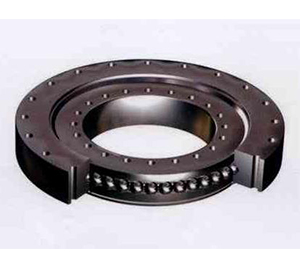
行业知识
Home>Industry knowledge>Content
In the vertical turning equipment, the rotary table is one of the central structures that express the overall performance of the machine tool and complete the processing accuracy of the workpiece. We require it to operate at high speeds and accept heavier workpieces, have precise running accuracy and very high anti-overturning moment ability, and the slewing bearing supporting the worktable is the key to accomplish this important task. In the past, most of the domestic workbenches used thrust bearings and radial bearings in cooperation. This arrangement has a complicated structure and uses more materials. Especially when installing large box parts, the space of the entire machine tool is larger. It is also difficult to install and adjust the preload of the slewing bearing, the alignment is even more difficult to ensure, and it is difficult to improve the overall accuracy of the worktable.
Therefore, more designs are now beginning to choose cross-roller bearings with a more compact structure, which not only saves material costs, but also simplifies design schemes, higher limit speeds, better running accuracy and stability, and stronger load-bearing capacity and rigidity. This article introduces Ruan's use of cross-roller bearings on vertical lathes to complete its perfect engineering performance.
1. Runout accuracy
Bearing run-out can be divided into synchronous run-out and asynchronous run-out. The impact of synchronous run-out on the overall run-out of the worktable can be reduced to the greatest extent by grinding the work surface, but the impact of asynchronous run-out cannot be eliminated in this link. It is mainly determined by the outer diameter and roundness of the roller. Therefore, the better the asynchronous runout control of the bearing, the smaller the final radial and axial runout of the worktable, that is, the higher the running accuracy. When selecting bearing brands and accuracy grades, it is recommended not to focus only on bearing installation runout, but to have a thorough understanding of the accuracy standards that affect bearing asynchronous runout.
2. Bearing cooperation
When selecting bearings, it is recommended that the inner ring and the shaft, and the outer ring and the gear ring be in close cooperation. Since the outer ring is a rotating part, the tight fitting amount should be slightly larger. The inner ring will be pressed down by the end cap and adjusted to a certain pre-tightening amount, so the tight fitting amount should be slightly smaller. However, if the inner ring is considered to be a static part, and the inner ring and the shaft are designed to be loose, there is a radial gap between the inner ring and the shaft, it is possible that the inner ring may be deflected when the inner ring is installed, locked, or the shaft is under load. Oblique, that is, migraine occurs. This kind of misalignment will cause stress concentration in the gap between the contact area of the roller and the raceway, causing serious scratches, pitting and shedding, and the bearing life will be completed earlier.
3. Form and position
The mounting surface of the shaft and the gear ring is required to have the same flatness, perpendicularity, roundness and cylindricity as the precision bearing. Controlling these shapes and positions can not only obtain better installation accuracy, but also avoid excessive stress concentration on the inner and outer rings of the bearing and prolong the service life of the bearing. Regarding the processing standards of the shape and position, it is recommended to consult the bearing supplier to match its bearing accuracy.
Fourth, the axial preload
In the cutting test of vertical turning, the end face and outer circle roughness of the workpiece are very concerned, and one of the keys to determine the advantages and disadvantages is the rigidity of the system. The system rigidity includes the rigidity of the frame structure, the rigidity of the supporting bearing, etc. The rigidity of the bearing often depends on its axial preload.
Therefore, it is particularly important to properly set the axial preload of the bearing with full consideration of the effects of temperature and load.
